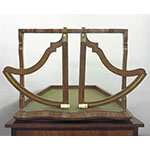This apparatus, described by Jean-Antoine Nollet in Leçons de physique expérimentale (Paris, 1743-1748), is a sort of small billiard mechanism resting on an elegant table. It was used to study the composition of elastic shocks. The device consists of a pair of hammers hinged in two rotating quadrants. Two ivory scales, inserted in the arcs, serve to measure the distance traveled by the hammers. By dropping the two hammers on a ball from different heights at different angles, one can observed the trajectory produced by the combination of two different momentums. The experiments can be varied, for example, by placing the quadrants at a distance from each other so that they strike two separate balls, which will collide on the plane. Provenance: Lorraine collections.










